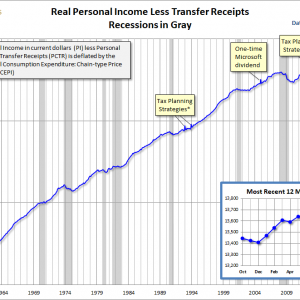Latest Posts
-
Finance 0
The Big Four Economic Indicators: Real Personal Income In October
Official recession calls are the responsibility of the NBER Business Cycle Dating Committee, which is understandably vague about the specific indicators on which they base their decisions. This committee statement is about as close as they get to identifying their method. There is, however, a general belief that there are four big indicators that the committee weighs heavily in their cycle identification process. They are: Nonfarm Employment Industrial Production Real Retail Sales Real Personal Income (excluding Transfer Receipts) The Latest Indicator Data Personal Income (excluding Transfer Receipts) in October rose to 0.43% and is up 3.5%...On November 30, 2017 / By Kurt Osterberg -
Finance 0
VMWare (VMW) Posts Q3 Earnings Beat, Revenue Gains 11%
VMWare, Inc. (VMW) released its third-quarter fiscal 2018 financial results, posting non-GAAP earnings of $1.24 per share and revenues of $1.98 billion. Currently, VMW is a Zacks Rank #3 (Hold) and was up 2.69% to $123.34 per share in after-hours trading shortly after its earnings report was released. VMWare: Beat earnings estimates. The company posted non-GAAP earnings of $1.34 per share, beating the Zacks Consensus Estimate of $1.27 per share. Beat revenue estimates. The company saw revenue figures of $1.98 billion, beating our consensus estimate of $1.96 billion. Revenue was up 11% year-over-year. Operating cash flows for the third quarte...On November 30, 2017 / By Kurt Osterberg -
Finance 0
Why The Fed Might Be OK With Higher Inflation In 2018
Neel Kashkari: Minneapolis Fed President Is Fine With 2.7% Inflation On the day of the release of the Beige Report which showed price pressures are strengthening as economic growth is steady, let’s review a comment Neel Kashkari made about inflation. Neel did a Q&A on Twitter. One of the questions asked was what level of inflation the Fed would need to see to increase rates considerably. He said that because the PCE was 1.3% for over 5 years, the Fed should be fine with inflation running at 2.7% for over 5 years. I’ve never understood the mandate to be like that. He said that’s why it’s called a target and not a ceiling. The way I...On November 30, 2017 / By Kurt Osterberg -
Finance 0
V-Tops And V-Bottoms: Natural Gas Winter Volatility Is Back
Natural gas volatility has returned as traders attempt to price in variable heating demand expectations into the middle of December. After three straight days of rallying, today prices declined, and the decline was not small. The January natural gas contract pulled back almost 5% after reversing off the 60-DMA yesterday. As would be expected with such heavy selling, losses were worst at the front of the strip, but even the Spring 2018 strip saw decent losses on the day too. Cash prices were of no help either. The result is that 30-day natural gas annualized volatility is now far higher than it was at any point this past summer or fall.�...On November 30, 2017 / By Kurt Osterberg -
Finance 0
It’s More Than Just The Absence Of Acceleration, It’s The Synchronization Where There Should Be None
According to the latest ECB figures, as of yesterday total “liquidity” added to the European banking system for that central bank’s ongoing monetary “stimulus” was just shy of €2 trillion. The outstanding balance in the core current account (reserves) held on behalf of the banking system was €1.296 trillion. In the deposit account, banks are holding €686 billion at -40 bps in “yield.” To create all these euro-denominated numbers, the European Central Bank through its constituent National Central Banks (NCB) has purchased €2.21 trillion through its three main active LSAP’s (Large Scale Asset Purchases): the PSPP, or QE,...On November 30, 2017 / By Kurt Osterberg -
Finance 0
McCain Mania Sends Dow Soaring To Record Highs As Yield Curve Collapse Continues
The longest short-squeeze streak in history continues… John McCain’s “Yes” at 1051ET seems to have been the catalyst that extended overnight gains into melt-up mania… (Small Cap smanaged to scramble back green on the day as Trannies rose 2%) But the Nasdaq remains red on the week… Futures show the crazy moves best… ...On November 30, 2017 / By Kurt Osterberg -
Finance 0
OK, So Trees Don’t Grow All The Way To The Sky
Tempting fate — it never fails to disappoint. Yesterday’s regular trading day, after I proclaimed nothing could get in the way of this latest leg of a bullish trading wave, things did. Market participants who’d been riding an enormous wave of technology looked at their year-to-date gains in companies like nVIDIA (NVDA – Free Report) , which had topped up 113%, and sold them off 10% yesterday. As for Bitcoin, I said nothing could stop it. Then one of its exchanges lost power, and the value of one Bitcoin fell more than $2000. Well, Bitcoin has since recovered a bit and nVIDIA is trading up in today’s pre-market. In fact, the Dow,...On November 30, 2017 / By Kurt Osterberg -
Finance 0
Market Talk – Thursday, November 30
The tech sector took the label of responsibility overnight in Asia for the reason given for most declines. The Hang Seng suffered the most falling near 1.5% following Wednesday price action in the Nasdaq. Even Shanghai lost 0.6% which was a surprise given the promising PMI print (51.8% against a consensus of 51.4%). Energy and commodity prices drifted even weaker today which hurt the Australian ASX index (-0.7%). In Japan the Nikkei rejected these moves, taking the moral high ground and rallied as exporters performed with a declining Yen. The calendar took the blame for stock declines in Europe today cutting losses for the month. The broad Eu...On November 30, 2017 / By Kurt Osterberg -
Finance 0
Profit Taking Sweeps Tech While Large Caps Gain
There was a clear shift in market behavior as Large Caps enjoyed the fruit of renewed buying as Tech indices (Semiconductors mostly) felt the heat of profit taking. After weeks of tight gains in the Semiconductor Index it was an easy turn for profit takers to come in and push the market down; in the absence of logical support, it was going to be a hard task to pinpoint where potential depend may lurk outside of 1,150. The 50-day MA may provide one such escape but there isn’t a whole lot to suggest it may play as support. The Nasdaq peeled away from resistance but it made a sufficient recovery to suggest it might yet make a fresh cha...On November 30, 2017 / By Kurt Osterberg -
Finance 0
Wanna Outdo The Market? Reweight It
Which alternative weighting scheme works best? There’s been a whole lot of noise made about strategic or smart beta in the past few years. Strategic beta represents a sort of middle ground ‘tween passive and active investing and seems a perfect niche for exchange-traded funds. Usually, strategic beta ETFs employ a transparent, if mechanistic, methodology designed to exploit some factor or inefficiency. Their goal, like actively managed portfolios, is to outperform the benchmark, but at a much lower cost than active products. The simplest way to obtain some excess return is to strategically reweight the market benchmark. Let’s take a loo...On November 30, 2017 / By Kurt Osterberg
Top Posts
-
 The Importance for Individuals to Use Sustainable Chemicals
The Importance for Individuals to Use Sustainable Chemicals
-
 Small Businesses: Finding the Right Candidate for the Job
Small Businesses: Finding the Right Candidate for the Job
-
 How to Write the Perfect Thank You Letter After Your Job Interview
How to Write the Perfect Thank You Letter After Your Job Interview
-
 3 Best Large-Cap Blend Mutual Funds For Enticing Returns
3 Best Large-Cap Blend Mutual Funds For Enticing Returns
-
 China suspected in massive breach of federal personnel data
China suspected in massive breach of federal personnel data















